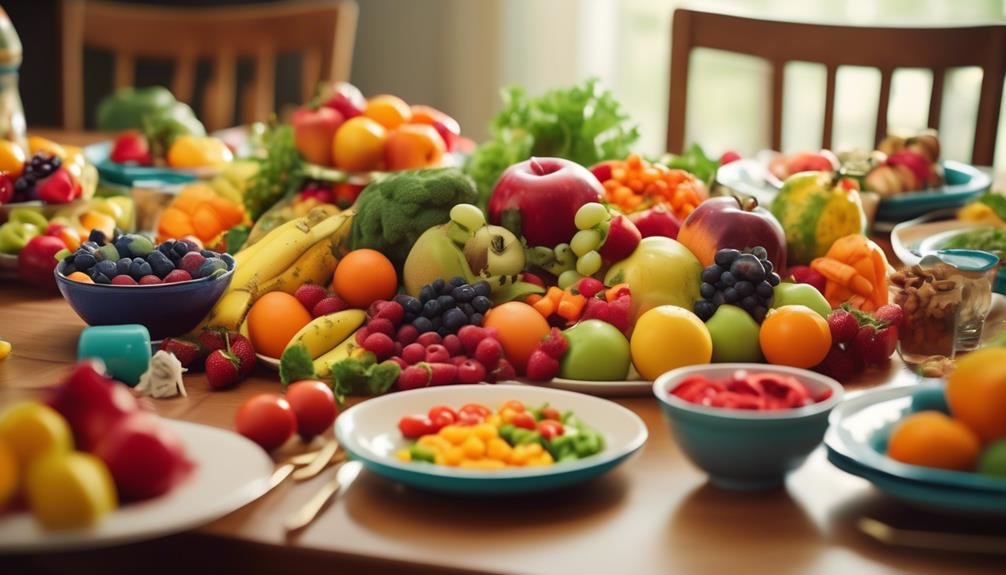"Cherishing Little Steps - A Haven for Baby and Family Journeys"
5-Year-Old Healthy Eating
When it comes to nourishing your little one, you want to ensure they have a well-rounded diet that supports their growth and development.
We all know that getting a 5-year-old to eat healthy can sometimes be a bit challenging, but fear not, there are strategies you can employ to make this journey easier.
From introducing new foods to dealing with picky eaters, we will explore various ways to encourage healthy eating habits in your child.
So, let's dive in and discover some practical tips that will pave the way for a lifetime of nutritious choices.
Key Takeaways
- Approach new foods with patience and a positive attitude
- Involve the child in choosing and preparing meals
- Model healthy eating behaviors
- Avoid pressuring or bribing the child to finish their plate
Introducing New Foods

When introducing new foods to your 5-year-old, it's important to approach it with patience and a positive attitude. Exploring flavors and developing taste preferences are crucial aspects of their healthy eating journey. Encourage your child to try a variety of foods to expand their palate and expose them to different tastes and textures. Start by offering small portions of new foods alongside familiar ones to make the experience less overwhelming.
To make it more exciting, involve your child in the process of choosing and preparing meals. Take them grocery shopping and let them pick out fruits and vegetables that catch their interest. In the kitchen, allow them to help wash, chop, or mix ingredients, fostering a sense of ownership and curiosity.
As you introduce new foods, be mindful of how you present them. Use positive language and avoid pressuring or bribing your child to eat. Instead, role-model healthy eating habits by enjoying a variety of foods yourself. Remember, it may take several attempts before your child develops a liking for a new food, so be patient and persistent.
Making Mealtime Fun
To make mealtime enjoyable and engaging for your 5-year-old, incorporate fun and interactive elements that encourage their participation and excitement.
One way to do this is by using creative presentation techniques. Try arranging the food on their plate to create fun shapes or patterns, or use colorful ingredients to make the meal visually appealing. For example, you can make a smiley face with sliced fruits or arrange vegetables to resemble animals. This not only makes the meal more appealing but also encourages your child to try new foods.
Another way to make mealtime fun is by involving your child in the cooking process. Let them help you in the kitchen by measuring ingredients, stirring, or even chopping vegetables (under close supervision, of course). This not only empowers them but also makes them feel like they're contributing to the meal. Additionally, it provides an opportunity for you to teach them about different foods and cooking techniques.
You can also make mealtime interactive by playing games or having conversations during the meal. Ask your child about their day or play a game where they've to guess the ingredients in a dish. This not only makes the meal more enjoyable but also creates a positive and engaging atmosphere.
Setting a Good Example

Setting a good example is crucial in promoting healthy eating habits for your 5-year-old. As a parent, you play a significant role in shaping your child's relationship with food. By leading by example and creating a positive food environment, you can instill healthy eating habits that will benefit them for a lifetime.
Children learn by observing and imitating their parents, so it's essential to model healthy eating behaviors. Show enthusiasm for nutritious foods and include a variety of fruits, vegetables, whole grains, and lean proteins in your meals. Avoid using food as a reward or punishment and instead focus on the enjoyment and nourishment that comes from eating well-balanced meals.
Creating a positive food environment involves making healthy options easily accessible and encouraging your child's involvement in meal planning and preparation. Take them grocery shopping and let them choose fruits and vegetables they want to try. Involve them in cooking and let them help with age-appropriate tasks, like stirring or tossing ingredients. This not only teaches them valuable skills but also empowers them to make healthier choices.
Encouraging Independent Choices
By fostering independence and empowering your child to make their own choices, you can further promote healthy eating habits at the age of 5. Encouraging autonomy in decision-making not only helps your child develop a sense of responsibility, but it also allows them to explore their own preferences and tastes when it comes to food.
One way to encourage independent choices is by involving your child in meal planning and preparation. Allow them to choose their favorite fruits and vegetables for the week and involve them in simple cooking tasks, such as washing and chopping vegetables. This not only gives them a sense of ownership over their meals but also helps them develop important skills in the kitchen.
Another way to foster healthy habits is by providing a variety of healthy options and letting your child decide what and how much to eat. Offer a range of nutritious foods at each meal and let them choose what they want to eat. Avoid pressuring or bribing them to finish their plate, as this can lead to unhealthy eating behaviors in the long run.
Remember to be a positive role model by showing enthusiasm for healthy foods yourself. Children are more likely to adopt healthy habits when they see their caregivers making nutritious choices. By encouraging autonomy and fostering healthy habits, you can set your child up for a lifetime of positive eating behaviors.
Dealing With Picky Eaters

Addressing picky eating habits in 5-year-olds can be challenging, but with patience and a strategic approach, it's possible to expand their food preferences and encourage healthier eating habits.
Here are some tips to help you deal with mealtime struggles and promote a positive eating environment for your picky eater:
- Be a role model: Children often mimic their parents' behavior, so make sure to demonstrate a positive attitude towards trying new foods and enjoying a variety of healthy options.
- Get creative with presentation: Sometimes, picky eaters are more willing to try new foods if they're presented in a fun and appealing way. Try cutting fruits and vegetables into fun shapes or arranging them into colorful patterns on their plate.
- Involve them in meal planning: Let your child have a say in what they eat by involving them in the meal planning process. Give them options to choose from and allow them to pick their meals occasionally.
- Gradually introduce new foods: Start by introducing small portions of new foods alongside their familiar favorites. Encourage your child to take a bite and praise their efforts, even if they don't like it. Over time, their taste buds may adjust and they may develop a liking for the new food.
- Offer a variety of options: Provide a range of healthy choices at mealtimes, including different types of fruits, vegetables, proteins, and whole grains. This ensures that your child gets exposed to a variety of flavors and textures.
Balancing Nutritional Needs
To ensure your 5-year-old's nutritional needs are balanced, focus on providing a variety of nutrient-rich foods in appropriate portion sizes. Promoting mindful eating and incorporating variety are key factors in achieving this goal.
Mindful eating involves paying attention to the taste, texture, and smell of food, as well as recognizing hunger and fullness cues. By encouraging your child to eat slowly and savor each bite, they can develop a healthier relationship with food and avoid overeating.
Incorporating a variety of foods into your child's diet is essential for meeting their nutritional needs. Different foods provide different nutrients, so it's important to offer a wide range of options. Include fruits, vegetables, whole grains, lean proteins, and dairy products in their meals and snacks. This not only ensures that they're getting a good balance of vitamins and minerals, but it also helps expose them to different flavors and textures, which can expand their palate and make them more open to trying new foods.
Remember to serve appropriate portion sizes for your child's age and activity level. This helps prevent overeating and teaches them to listen to their body's hunger and fullness signals. By providing a variety of nutrient-rich foods and promoting mindful eating habits, you can help your 5-year-old develop a healthy relationship with food and meet their nutritional needs.
Frequently Asked Questions
How Can I Ensure That My Child Is Getting All the Necessary Nutrients While Following a Year-Old Healthy Eating Plan?
To ensure your child gets all necessary nutrients, focus on balanced meal planning. Include a variety of fruits, vegetables, whole grains, lean proteins, and dairy. Offer small portions, encourage self-feeding, and model healthy eating habits.
What Are Some Creative Ways to Make Mealtime Fun for My Child?
To make mealtime fun for your child, try creative mealtime activities and fun food presentations. You can involve them in meal preparation, use colorful plates and utensils, or make fun shapes with fruits and vegetables.
How Can I Encourage My Child to Try New Foods Without Pressuring Them?
You can encourage your child to try new foods without pressuring them by giving them autonomy and building healthy habits. Offer a variety of options and let them choose what they want to try.
What Are Some Strategies to Deal With Picky Eating Habits in a One-Year-Old?
To deal with picky eating in a one-year-old, try these strategies: offer a variety of foods, be a role model by eating healthy yourself, involve your child in meal preparation, and don't force them to eat.
Is It Important to Involve My Child in the Decision-Making Process When It Comes to Their Food Choices?
It's important to involve your child in food choices. When children have a say in what they eat, they feel empowered and more likely to develop healthy eating habits. It also exposes them to a variety of foods.
Conclusion
As you conclude your journey towards a 5-year-old's healthy eating habits, remember that introducing new foods and making mealtime fun is key. Set a good example and encourage independent choices to empower your child.
Don't fret over picky eaters; patience and creativity will prevail. Remember to balance their nutritional needs and ensure a well-rounded diet.
By following these steps, you'll nourish their bodies and minds, setting them up for a lifetime of healthy habits.
Happy eating!



8nus9m